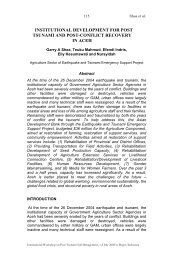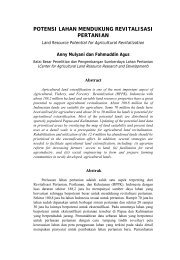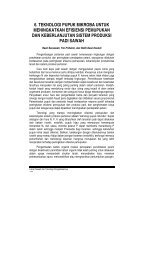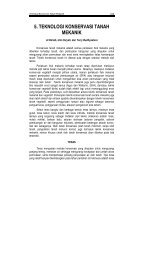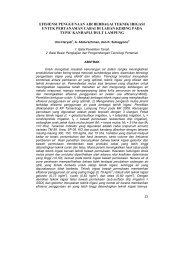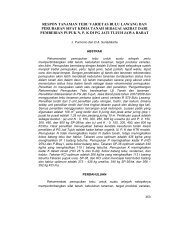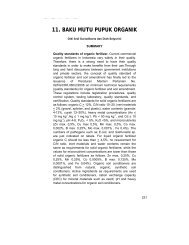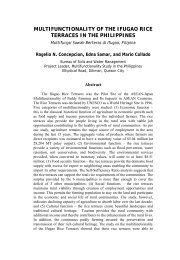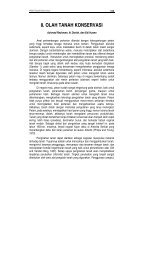Proceedings - Balai Penelitian Tanah
Proceedings - Balai Penelitian Tanah
Proceedings - Balai Penelitian Tanah
Create successful ePaper yourself
Turn your PDF publications into a flip-book with our unique Google optimized e-Paper software.
26<br />
Niino Y<br />
productivity that were achieved prior to the tsunami; and the<br />
cultivation of sun hemp and its incorporation into the soil as a green<br />
manure showed to be an effective tool in reducing salinity. In addition,<br />
the application of large quantities of organic matter was demonstrated<br />
to improve the productivity of saline affected soils (FAO, 2008).<br />
Soil samples were collected to assess the degree of salinization and<br />
permanent monitoring sites established to assess the degree of<br />
remediation associated with the monsoon. There was clear evidence<br />
to indicate that significant leaching and flushing of salts occurred<br />
associated with natural rainfall. Field demonstration plots were<br />
established to evaluate different strategies and adoptable crop<br />
species. In addition, crop recommendations were made based on soil<br />
salinity levels. Damaged wells were reconstructed, by pumping out of<br />
saline waters where needed. Capacity building in salinity reclamation<br />
through the field and institutional training activities along with the<br />
establishment of crop demonstration plots in the field was also<br />
emphasized. The introduction of cowpea, sunflower, and vegetables<br />
was identified as a very effective strategy in enhancing existing<br />
production systems.<br />
Thailand<br />
The effects of the tsunami in Thailand were confined to coastal<br />
communities along the Andaman Sea. A total of 5,800 people died<br />
with 2,900 declared missing; 3,600 houses were destroyed and 412<br />
communities were affected. The worst affected Province was Phang-<br />
Nga where 4,225 people lost their lives and 4,394 households were<br />
affected by the disaster. Within the Province 957 ha of agricultural<br />
land was lost and 412 farmers were affected. Along with this, livestock<br />
were destroyed and natural resources (i.e. mangroves, beaches,<br />
corals and fresh water) were all negatively impacted.<br />
External agencies such as FAO provided coconut, oil palm and<br />
cashew nut seedlings for 94 ha. Similarly, gypsum, inorganic and<br />
organic fertilizers and vegetable seeds were supplied to farmers for<br />
rehabilitation and establishment of crops. Selected farmers were<br />
provided with inexpensive vegetable hydroponic kits and associated<br />
training. A key element in moving forward was the promotion of<br />
diversified production systems along with the establishment of<br />
markets.<br />
A soil salinity classification system was developed for the tsunami<br />
affected land based on high resolution satellite imageries and aerial<br />
photos and the attributes including present land use, type and extent<br />
of damage, salinity level, soil texture, and water table depth were<br />
developed (FAO, 2006b). Sedimentation was a significant factor in the<br />
International Workshop on Post Tsunami Soil Management, 1-2 July 2008 in Bogor, Indonesia



